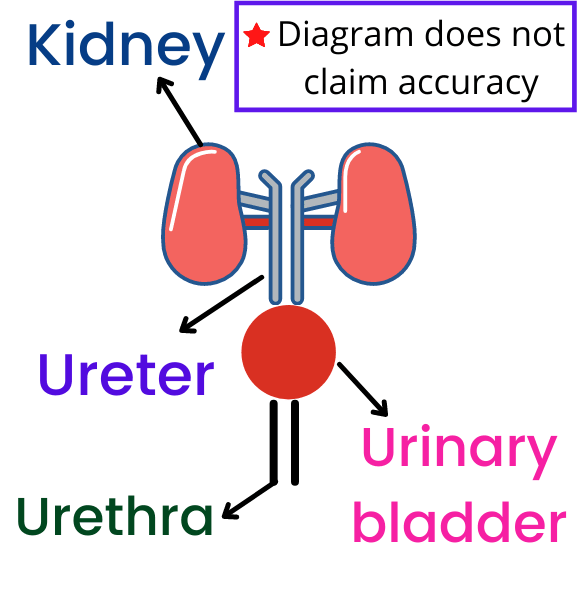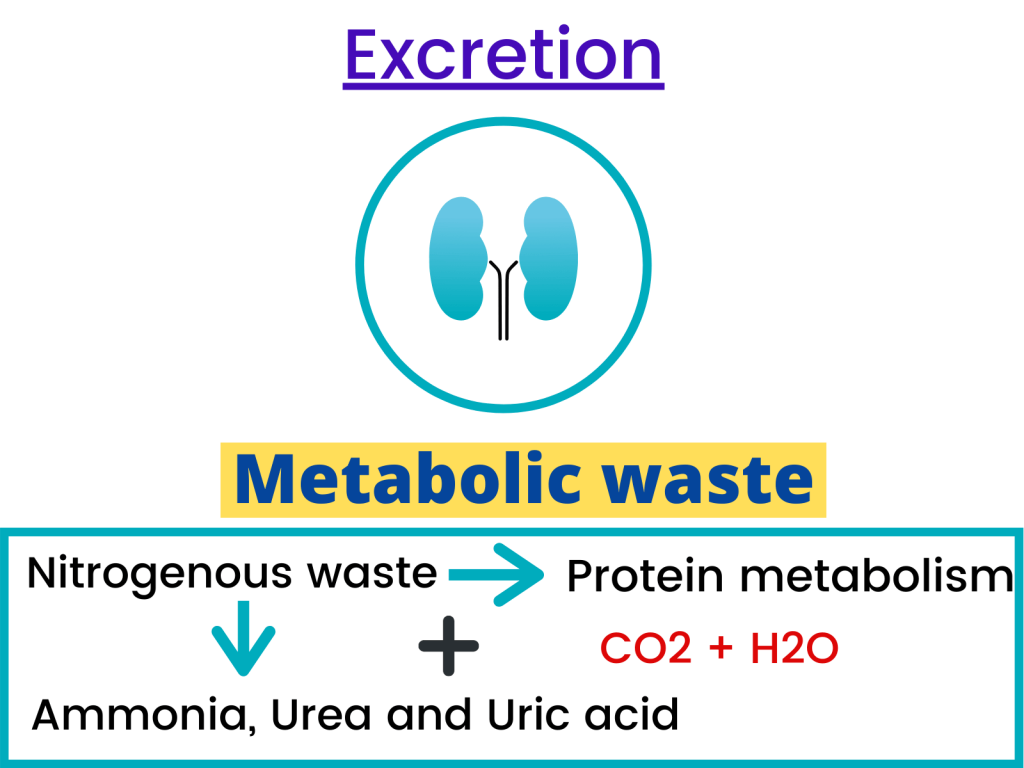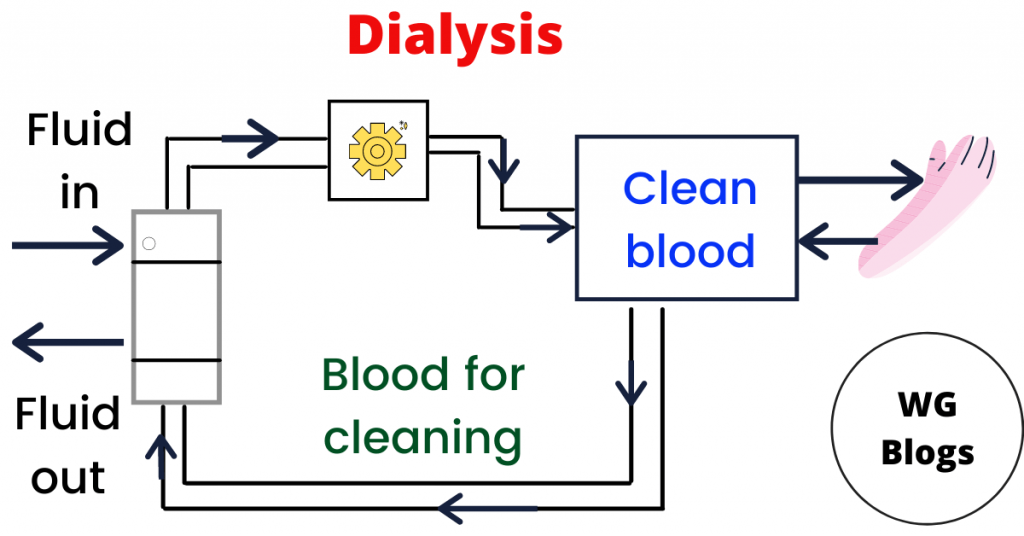Excretion is a process in which the metabolic waste (waste which is produced as a result of chemical changes in a cell) is eliminated from an organism’s body.
Humans have specialised organs to carry out this process but primarily, the lungs, liver, kidneys and skin carry out this process.
Now you might be wondering, why is it important for our body to carry out this process? Let me tell you.
The metabolic waste which is produced as a result of metabolic processes is toxic and harmful for the body. Therefore, they either have to be removed (excreted) or converted into harmless substances.
This was all about the introduction of this topic. Now, let’s discuss some important concepts in detail.
Excretion:
The excretory system in mammals:
When studying about excretion, make sure that you completely understand the following terms:
- Egestion: Process of discharging undigested food as faeces
- Excretion: Process of removing toxic materials from the body
- Secretion: Release of useful substances by a gland or cell
You should also know that the mammals consist of a urinary system which consists of a pair of kidneys, urinary bladder, urethra and ureters. They play a very vital role in the process.

Kidneys are the reddish-brown bean-shaped organs in vertebrates (lying above the waistline) and a normal mammal has two kidneys (one on the right and the other on the left which is slightly higher.
Then, we have the ureter. The ureter is a tube which carries urine to the urinary bladder from the kidneys and each kidney has a ureter. In an average adult, the length of the ureter is around 10 to 12 inches long.
Moreover, the lower part of the ureter is located in the pelvic area while the upper part is located in the abdomen.
The urinary bladder is a hollow and muscular organ in the human beings that serves to store urine coming from the kidneys through the ureters. This muscular and elastic bag has sphincter muscles.
When sphincter muscles relax, the urine flows out through the urethra (thin tube at the lower end of the bladder) but when they contract, no more urine passes out.
These are some of the organs that help to eliminate metabolic waste products from our body and their functions are summarised below.
- Kidneys: Produces urine
- Ureter: Carries urine from kidneys to the urinary bladder
- Urinary bladder: Stores urine
- Urethra: It conducts urine
The metabolic waste products:
You should also know what products are the “metabolic waste products” and which excretory organ removes them.
Carbon dioxide is a main excretory product of aerobic respiration (respiration carried out in the presence of oxygen) which is removed by lungs during exhalation (breathing out).
Then, we have the nitrogenous waste products such as urea and uric acid. When proteins are deaminated, urea is produced which is excreted through the kidneys via urine.
However, the uric acid is a constituent of sweat which is excreted through the skin. The kidneys (through urine), skin (through sweat) and lungs (through expired air) remove the excess water from the body.

This takes us to another very important topic which is about the structure of the kidney. So, let’s take a look at the topic now.
Structure of kidneys:
If you view the mammalian kidney from a longitudinal section, you will find that the renal cortex, renal medulla and renal pelvis are the main internal regions of a kidney.
The masses of tiny tubules, Nephrons, are located inside the medulla and they receive fluid from renal cortex and blood vessels.
In simple words, there is an outer cortex, a central medulla and a renal pelvis that is located in the region which is known as the hilum (point of entry and exit for blood vessels) of a kidney.

The main function of kidneys is to produce urine in order to remove the metabolic waste products from a body. But how urine is produced? Let me tell you.
But, before that, you should know that the blood enters the kidney through the renal artery (which divides into capillaries) while the blood exits the kidney through the renal vein.
In the formation of urine, there are two major processes involved which are:
- Ultrafiltration (filtration in kidneys)
- Selective reabsorption (of useful substances)
The removal of fluid from an organism is known as ultrafiltration. When the blood enters the kidney, mechanical filtration occurs. This filtration (ultrafiltration) traps all solid and large molecules. However, only very small molecules pass through.
Note: The hydrostatic pressure in the glomerulus and the force from the blood vessels is the main driving force that pushes the filtrate out of the capillaries.
Now you might be wondering, are large molecules such as proteins and platelets are also taken away during urine formation? No, the process of selective absorption comes here.
Further reading:
Energy Changes | GCE O Level Notes
Redox reactions | GCE O Level Notes
Organic chemistry notes (5070)
During the mechanical filtration inside the kidneys, some useful substances from the body such as proteins are unable to pass out through the filtrate because they have large molecules.
Therefore, the body reabsorbs these useful substances into the bloodstream because if the body loses them, you are likely to dehydrate and lose vital nutrients. Some of the substances reabsorbed into the bloodstream are:
- Glucose
- Amino acids
- Mineral salts
However, excess water, nitrogenous waste products, urea and uric acid are the constituents of urine and its composition varies from person to person.
Osmoregulation:
During urine formation, water is one of the main components. In a normal adult, around 120 cm3 of filtrate is formed every minute.
What if the water is lost at a very fast rate? What if your body wants to lose more water? How does your body regulate the water potential? The answer to all these questions is osmoregulation.
Osmoregulation refers to the regulation of osmotic potential in one’s body to maintain homeostasis of the water content. The water content in a human body is controlled by the antidiuretic hormone (ADH).
- When the water potential in the body increases (osmotic pressure decreases), less ADH is secreted.
This is because the antidiuretic hormone is responsible to absorb water. Therefore, less water is absorbed by the kidney tubules and more water is secreted out.
As a result, water potential becomes constant (normal). This is known as negative feedback because the body makes an opposite change to the stimulus to counter it.

- When the water potential decreases (osmotic pressure increases), more ADH is secreted.
As a result, more water is absorbed in the kidney tubules and less water is secreted out through the urine. This regulates the water potential as the stimulus (change) is countered.
Function of kidneys:
The kidneys maintain the overall fluid balance, filter waste and toxic materials, regulate and maintain the mineral content, produce red blood cells and regulate the blood pressure.
Moreover, the kidneys also remove drugs from the body. They produce an active form of vitamin D which improves bone health and water balance is also regulated.
To summarise, some of the functions of kidneys are:
- The composition of blood plasma is maintained through selective absorption
- The toxic and waste products (such as excess mineral salts) are excreted as urine
- The salt and water balance is regulated
- Produces red blood cells
- Drugs are removed from the body
These are some of the vital functions of kidneys with which you should be familiar. Now, it is time to discuss some important concepts about kidney failure and dialysis.
Kidney failure and dialysis:
There are two kidneys in a normal human being and even if one fails to work, a person can live and healthy and normal life. However, if both kidneys fail to work, a process known as dialysis is carried out.
Dialysis is essential because if the toxic materials accumulate into the bloodstream, it can be very dangerous. Therefore, dialysis is carried out to purify blood through a machine.

Firstly, blood is taken out from the artery of the patient and it is directed towards the tubing of the dialysis machine. Secondly, the tubes of the machine are partially permeable (only allow some substances to pass through).
The small molecules such as uric acid, urea and some nitrogenous waste products diffuse out of the tubing. However, the large molecules such as proteins and platelets remain in the tubing (which then return to the patients blood through the vein).
This is the process which is used to purify the blood. Now, I have a question from you over here. Why is the blood taken from the artery but not from the vein even though it intends to be purified?
Conclusion:
With this, our topic about excretion has come to an end. I hope that all your queries have been cleared and all the questions have been answered.
You should practise plenty of past paper questions to ace this topic as it is a very important topic from examination point of view. Some of the topics covered in this article are the structure and function of kidneys, the formation of urine and dialysis.
Thank you very much for reading and staying with me till the end.
